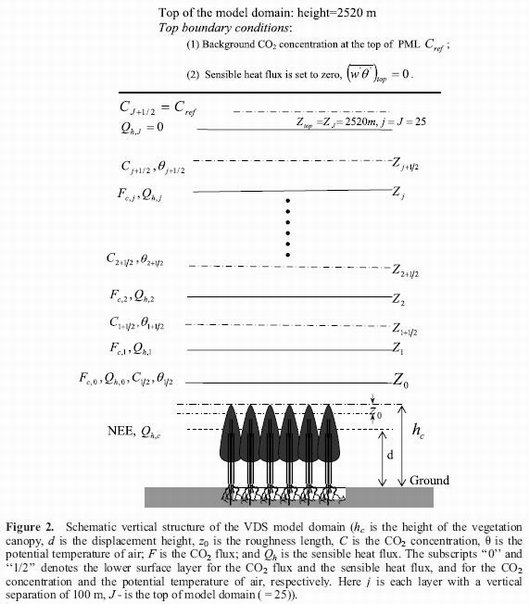|
VDS(Vertical Diffusion Scheme) was developed to investigate
the vertical CO2 transport in the PBL and to evaluate CO2
vertical rectification. The VDS was driven by the net ecosystem
carbon flux and the surface sensible heat flux, simulated
using the Boreal Ecosystem Productivity Simulator (BEPS) and
a land surface scheme--Ecosystem-Atmosphere
Simulation Scheme (EASS). These three components are linked through
two prognostic variables: land surface sensible heat fluxes
affecting the mixed layer development, and net ecosystem productivity
(NEP) driving vertical CO2 transfer, which are calculated
using EASS and BEPS, respectively, at each computing time
step. The VDS is designed to simulate scalar diffusion processes
in the planetary boundary layer (PBL). These processes modify
the lowest 100 to 3000 m of the atmosphere, though the troposphere
extends from the ground up to an average of 11 km [Stull,
1993]. The maximum top boundary height in VDS is 2520 m. Generally,
over the land surface under a high-pressure weather system
the PBL has a well-defined structure that evolves in a diurnal
cycle [Stull, 1993]. The four major components of this structure
are the surface layer, the stable boundary layer, the convective
boundary layer, and the residual layer. Many researchers use
second-order closure or higher-order closure methods to study/
simulate the complex diurnal evolutions of the PBL at the
expense of high computation power. First-order closure is
often called the gradient transport theory or well-known K-theory.
Although it is one of the simplest parameterization schemes,
it is only applicable in situations dominated by small-eddy.
Unfortunately, it frequently fails when large eddies are present.
Furthermore, in the real atmosphere, there are occasions where
transport occurs against the gradient (i.e., counter gradient)
[Stull, 1993]. Thus, K-theory is not applicable for use in
convective mixed layers. Hence to minimize the problem, we
selected different schemes to treat different situations of
the PBL structure. One is a stable/nocturnal module in which
K-theory is used; another is a free-convection module which
is based on Estoque's principles [Esoque, 1968; Blackadar,
1976, 1978]. The criteria that determine which module is applicable,
as shown in Figure 1, are the sign and magnitude of the bulk
Richardson number Rb in the surface layer and the magnitude
of the height of the mixed layer and the Monin-Obukhov length[Zhang
and Anthes, 1982].
The VDS model is integrated with the surface fluxes calculated
using coupled BEPS-EASS at 1-min computing time steps. This
model includes four major components (Figure 1):
- the surface scaling parameterizations,
- convective boundary layer (CBL) sub-model,
- stable/nocturnal module, and
- free convection module.


For details, Click here.
|